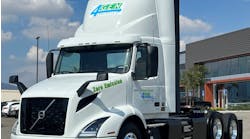Solutions that can cut CO2 emissions by as much as 25% from existing vehicles were among the winners in a competition over in Europe conducted by the Low Carbon Vehicle Partnership (LowCVP). The winners of the Low Carbon HGV Technology Challenge are developing unique technologies that, while being developed by European firms, certainly have the attention of major global manufacturers.
Each of the six winners will present their technologies and findings to a group of select manufacturers and fleet operators, including representatives of Allison Transmission, DAF Trucks, Daimler, Iveco, and Volvo Trucks.
LowCVP is an advisory and action group established in 2003 to encourage UK businesses to shift their vehicle fleets to low-carbon vehicles and fuels. There are approximately 200 member organizations from the automotive and fuel industries, the environmental sector, government, academia and road user groups.
The goal of the contest was to find ways to improve fuel economy and cut CO2 emissions. Most of the winning technologies, according to LowCVP, can be retrofitted onto existing trucks, making the technologies viable for any fleet operator looking to improve their carbon profile.
“The LowCVP’s HGV Technology Challenge shows the high capacity of UK engineers to develop innovative and effective solutions to help us tackle climate change,” said Greg Archer, LowCVP managing director. “The Challenge brings these great ideas to the attention of potential partners and customers providing both new market opportunities for some outstanding UK businesses and hastening the introduction of low carbon innovations in the HGV market that also reduce fuel costs.
“We are heartened by the strong support the initiative has received from both technology companies and major vehicle manufacturers and fleets, demonstrating their commitment to finding new solutions for reducing carbon emissions from trucks,” he added.
“We’ve spent several years developing and fine‐tuning our product, working with fleets and trailer
manufacturers, looking at technical and operational viability,” said Pauline Dawes of Somi Trailers, one of the winners. “We’ve had independent trials carried out and know our idea has potential. However, we also recognize that end‐users can be inundated with ideas. Winning the Technology Challenge will provide the opportunity for us to distinguish ourselves from the noise and, hopefully, attract new customers.”
The winners were selected based the merits and impacts of the technology for reducing CO2 emissions, commercial viability, and ease of integration.
The winners
Hardstaff Group (www.hardstaffgroup.co.uk): The Hardstaff Group has been using dual fuel in its heavy-duty vehicles. The company operates about 60 vehicles on dual fuel, substituting up to 70% of diesel fuel with natural gas, resulting in an 18% reduction in CO2 emissions.
Somi Trailers Ltd (www.somitrailers.com): The company’s 4 meter (13.1 ft.) high trailers increase capacity and lower costs, allowing fleets to haul the same amount of goods in three trailers that would take normally take four.
MIRA Ltd (www.mira.co.uk): Engineering company redesigned a 4.5 meter (14.7 ft.) high trailer to reduce drag. In a test project, the company claimed drag reductions of nearly 30%, resulting in a fuel and CO2 savings of between 15 and 20%.
Zeta Automotive (www.thezetagroup.com): Initially created for use with light vans, and now developed for heavy trucks, the company’s EconoSpeed can be fitted to any vehicle with an electronic throttle, and sits between the accelerator pedal and the engine’s ECU computer. The product limits the maximum rate of acceleration and forces earlier gear changes by limiting RPM. Combined with a top-speed limit, the device “mimics” the behavior of an economical driver and can be retrofit in less than an hour.
RDS Europe Ltd: RDS offers a hydraulically actuated parallel hybrid technology that demonstrates a 25% fuel savings in stop/start urban driving. Similar reductions in CO2, NOx, and particulates are seen, the company said.
Flybrid Systems and the Flybus Consortium (www.flybridsystems.com): The group, comprised of variable drive developer Torotrak, bus maker Optare, engineering group Ricardo, and supported transmission supplier Allison Transmission, has developed the Flybrid system. Initially designed for Formula One cars, the system is now being developed for heavy-duty trucks. It uses a high-speed flywheel that gathers energy when the vehicle is braking to turn the flywheel as fast as 60,000 rpm. That stored energy is then used to assist in the launching of the vehicle, reducing fuel usage.


